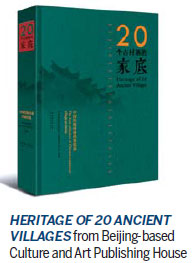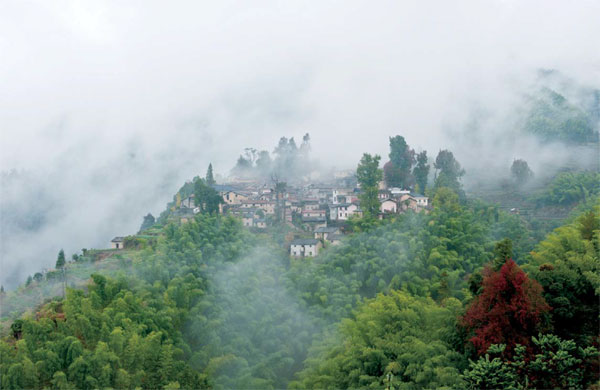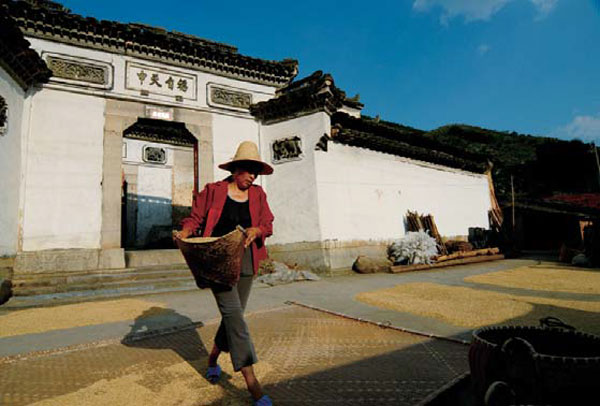Treasuring a nation's roots

Book on 20 ancient villages aims to raise awareness of the need to preserve some of the most significant rural gems while they still exist
Author and artist Feng Jicai has spent the past two decades investigating and trying to protect folk heritage, which is vanishing amid fast changes in Chinese society.
Among his recent books on folk culture is Heritage of 20 Ancient Villages from Beijing-based Culture and Art Publishing House.
| Xike village in Zhejiang is enveloped in a veil of mist. Photos by Lyu Jintian / For China Daily |
| Rooftops of traditional houses feature delicate brick carvings and calligraphy. |
| A local farmer during the harvest season. |
The 74-year-old's interest in the country's ancient villages can be traced back to 2002, when he led a group of cultural experts to Hougou village in North China's Shanxi province.
The official study of ancient villages in China started in mid-2014, under the ministries of housing and urban-rural development, culture and finance, and the State Administration of Cultural Heritage.
"China is going through fast transformation, from an agricultural society to an industrial one. So we regard this heritage as our cultural wealth, which we must protect," Feng said at a recent ceremony to launch his book in Beijing.
"In the past, folk culture was inherited naturally from one generation to another, but not anymore. It is the responsibility of intellectuals like ourselves to think about it and act."
Feng's knowledge of ancient villages comes from his travels across the country, says Pu Jiao, deputy director of China's Traditional Village Protection and Development Research Center.

Feng says he expects about 1,500 more such villages will be added to the current list of 2,555 compiled after three rounds of data analysis. To qualify, the villages must not only have a long history and still exist, but also have unique architecture and cultural value.
Kaiyangbao village in Hebei province dates backs to 295 BC in the Warring States Period (475-221 BC).
In East China, Fujian's tulou, which are fortress-like residences built with soil, wood and rocks, present a unique style and local culture with their circular or square shapes. The tulou was added to UNESCO's World Heritage list in 2008.
In little over a year, information on more than 240 ancient villages in China has been archived.
"We want to set up a model for such archival works," says Feng. "We want the public to know about the ancient villages as well as our work through the new book."
In Heritage of 20 Ancient Villages, the locations are recorded both in text and through photos. It provides basic information about the villages, including when and why they were formed and the state they are in today. Photos show images of the villages and depict their cultural heritage, folklore, economy and residents.
"We try to record concrete and comprehensive information in a scientific way - not just the names of those villages - so that in the future when people want to learn about the villages they can do research based on our archives," Pu says.
"We don't have much time to talk about how to protect them because urbanization is happening so quickly. We have to first compete with time and excavators to record as much information as possible."
As Feng says, the book and archiving of materials on such villages isn't the work of a single generation. The process will continue.

"Even after the buildings are torn down, their cultural value will be noted one day," Pu says. "The archive is open. Anyone with valuable information on the villages can enrich it."
In choosing the 20 cases for the book, the research team tried to include a lot of geographical diversity, "so as to include unique villages with prominent characteristics that best represent the regional culture in different places", she says.
The 20 villages are scattered across 12 provinces and municipalities, including Hebei, Shanxi, Zhejiang, Fujian and Guangdong provinces, the Ningxia Hui autonomous region, and Beijing and Chongqing.
One of the ancient villages that impressed Pu the most is Hougou in Shanxi.
The village is well preserved, and in terms of a general layout, it strictly follows the rules of feng shui. Formed during the Ming Dynasty (1368-1644), the village has many Taoist and Buddhist temples with stone tablets. The architectural style is that of cave houses that often are built into hillsides.
"The drainage system built in ancient times is used even today. People still make a lot of cloth products by hand, such as pads for shoes and stuffed toys," Pu says.
Chinese civilization is rooted in rural life. Folklore and tangible and intangible cultural heritage were all born in the villages, she adds.
"If the ancient villages vanish, their cultural heritage will be gone. That will be a tremendous pity for our country. That's why we are trying to collect as much information about them as possible."
yangyangs@chinadaily.com.cn
(China Daily European Weekly 03/11/2016 page20)
Today's Top News
- Takaichi must stop rubbing salt in wounds, retract Taiwan remarks
- Millions vie for civil service jobs
- Chinese landmark trade corridor handles over 5m TEUs
- China holds first national civil service exam since raising eligibility age cap
- Xi's article on CPC self-reform to be published
- Xi stresses improving long-term mechanisms for cyberspace governance

































